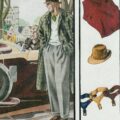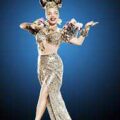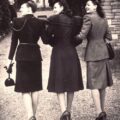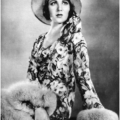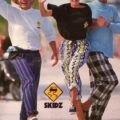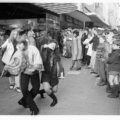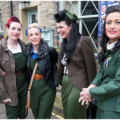Overview Of 1930s Fashion
The 1930s marked a significant shift in fashion, reflecting both societal changes and technological advancements. Women’s and men’s styles evolved to embrace practicality without losing elegance, while children’s fashion mirrored the creativity and resilience of the era. Hollywood’s influence was profound, making glamour accessible to many. An overview of 1930s fashion for the period 1930 to 1939 was defined by innovations that not only transformed clothing but also made high fashion more attainable.
Women’s Fashion Trends
The 1930s saw an evolution in women’s fashion, moving away from the boyish look of the 1920s to a more defined and feminine silhouette. Clothes began to celebrate a woman’s natural shape.
Bias cut clothing, pioneered by Madeleine Vionnet, became a standout trend. Cutting fabric at a 45-degree angle against its weave created garments that clung to the body’s curves, giving dresses a smooth, flowing elegance perfect for evening events.
The return of the natural waist was another major shift. Waistlines came back into their own, providing structure and definition to dresses. Whether for daywear or something more glamorous, women’s clothes accentuated the waistline, giving a more sophisticated appearance.
The dramatic backless dress emerged as hemlines dropped back to the floor. Designers crafted low-back and even completely backless gowns, developing undergarments that provided support while remaining discreet.
Hollywood’s influence on 1930s fashion was significant. Glamorous stars like Greta Garbo, Joan Crawford, and Marlene Dietrich became fashion icons. Crawford’s ruffled white organdie gown in the film “Letty Lynton” sparked a fashion frenzy, resulting in thousands of imitations.
Overview of 1930s fashion – Daywear and Evening Wear
- Daywear favored practicality without sacrificing style
- Cotton prints, silks, and wool crepes were popular
- Skirt hems reached mid-calf
- Dresses featured plaids, florals, and geometric prints
- Shoulders became a focal point, often padded and sculpted
Evening wear transformed women into goddesses with floor-length gowns in rich materials like silks and satins, carefully designed to create a flattering silhouette. Plunging necklines, elegantly draped fabrics, and dazzling embellishments were common features.
Accessories remained crucial, with hats, gloves, and handbags completing the look. Shoes featured lower, wider heels for comfort, with Mary Jane and T-strap styles particularly popular.
Despite economic constraints, innovations allowed fashion to remain stylish. Rayon became a popular, affordable alternative to silk, while man-made fibers like nylon revolutionized hosiery.
The overview of 1930s fashion celebrated the body’s natural form while maintaining elegance and sophistication. Women, influenced by Hollywood glamour, strove to replicate the allure they saw on the silver screen, embracing styles that adorned the female form with grace and style.
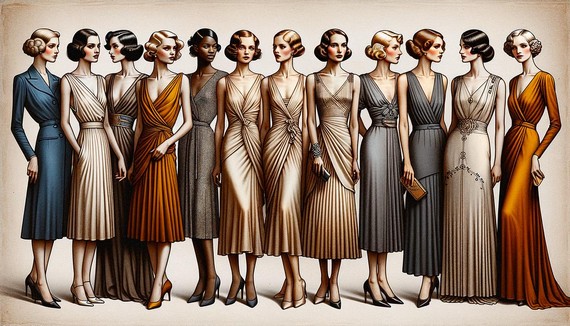
A group of elegant women wearing 1930s fashion, including bias-cut dresses, backless gowns, and mid-calf skirts with defined waistlines
Overview of 1930s fashion – Men’s Fashion Trends
Men’s fashion in the 1930s was shaped by a mix of Hollywood glamour and practicality. The overall look became more relaxed yet remained stylish, inspired by silver screen icons like Clark Gable and Cary Grant.
Suits and Formal Wear
- Suits adopted a more streamlined look
- Padded shoulders, cinched waists, and tapered trousers created an athletic silhouette
- Wide lapels and double-breasted jackets were popular
- Materials included tweed, wool, linen, and lighter cottons
- Sharkskin, a synthetic fabric, gained traction for its smooth appearance
Hollywood’s influence in the overview of 1930s fashion was significant. Clark Gable made going without an undershirt a trend after his bare-chested scene in “It Happened One Night.” Casual wear like sweaters, cardigans, and sports jackets became go-to items for a polished yet laid-back look. The classic trench coat and leather “Bomber” jacket also gained immense popularity.
Sportswear rose to prominence as physical fitness became important for modern men. Wide-legged trousers paired with button-down cotton shirts were ideal for both comfort and style. Tennis and golf influenced fashion design, bringing soft-collared shirts and slacks into mainstream casual wear.
Accessories continued to play a crucial role. Fedora hats, pocket squares, and ties became essential finishing touches. Although the necessity for formal gloves and canes was waning, a neatly folded handkerchief in the breast pocket added an understated, elegant flair.
The overview of 1930s fashion democratized men’s wardrobes without diminishing their style. By incorporating influences from Hollywood and sports, along with advancements in fabrics, the decade created enduring trends that balanced formality with casual elegance, setting the stage for future decades where versatility became central to men’s style.
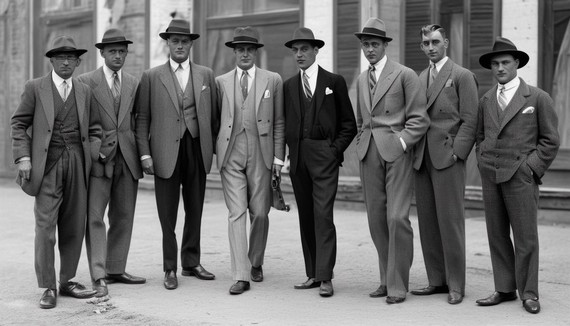
A group of dapper men in 1930s attire, including tailored suits with wide lapels, fedora hats, and casual sportswear
Overview of 1930s fashion – Children’s Fashion
The 1930s brought significant changes to children’s fashion, mirroring broader societal and economic shifts. The Great Depression influenced both materials and styles that became popular.
Shirley Temple, Hollywood’s child star, was a major fashion influencer for children. Her ringlet-curled hair and charming dresses captivated audiences, turning her fashion choices into must-haves for young girls worldwide. Sears Roebuck even launched a Shirley Temple line of clothing.
Overview of 1930s fashion – Girls’ Fashion
- Dresses featured natural waistlines, often with puffed sleeves
- Peter Pan collars and A-line skirts falling just above the knee were popular
- Affordable and practical cotton and muslin were common materials
- Embellishments like embroidery, piping, and ruffles added a playful touch
The flour sack dress became a symbol of Depression-era ingenuity. Families repurposed patterned cotton flour sacks into charming, practical dresses for girls, showcasing the creativity and resilience of the time.
Overview of 1930s fashion – Boys’ Fashion
- Sailor suits remained popular
- Older boys wore wool or flannel suits for formal occasions
- Corduroy shorts, cotton shirts, and woolen jumpers were common for younger boys
- Older boys transitioned to flannel trousers and jackets, often worn with suspenders
The emphasis on fitness and outdoor activities in the overview of 1930s fashion extended to children’s clothing. Sports-inspired outfits became part of everyday wear, with knitted sweaters, shorts, and practical shoes enabling active play.
In summary, 1930s children’s fashion balanced practicality with a touch of Hollywood glamour, influenced by child stars like Shirley Temple. The creative use of materials during the Great Depression illustrated the resilience of families, while the overall trends showcased a blend of practicality, economy, and inspiration drawn from both the silver screen and the changing economic landscape.
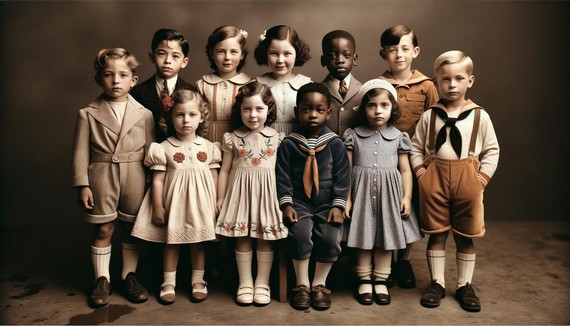
A group of children in 1930s clothing, including girls in Shirley Temple-inspired dresses and boys in sailor suits and corduroy shorts
Overview of 1930s fashion – Influence of Hollywood
Hollywood’s impact on 1930s fashion was profound, elevating movie stars to style icons and popularizing trends beyond the silver screen. The glamour of cinema offered escapism from the Great Depression and inspired everyday people to emulate their favorite stars.
Leading ladies like Greta Garbo, Marlene Dietrich, and Joan Crawford became fashion muses. Their on-screen wardrobes dictated trends and provided a glimpse into a world of luxury and sophistication. Garbo’s androgynous style, Dietrich’s sultry looks, and Crawford’s dramatic gowns became blueprints for women’s fashion.
Costume designers like Gilbert Adrian at MGM played a crucial role. Adrian’s creations, such as the white organdie gown worn by Joan Crawford in “Letty Lynton” (1932), sparked nationwide trends. His designs embodied the opulent fantasies of the era, allowing everyday women to experience a taste of Hollywood glamour.
Hollywood’s influence in the overview of 1930s fashion extended to men’s fashion as well. Clark Gable’s casually unbuttoned shirt in “It Happened One Night” famously led to a dip in undershirt sales, showcasing the impact of relaxed, informal styles.
The film industry also influenced make-up and beauty standards. The rise of the cosmetics industry was partly due to women seeking to replicate the looks of their favorite stars. Max Factor, for instance, started in Hollywood before his products became commonplace in homes worldwide.
Hollywood’s reach democratized fashion, making it more accessible to the public. Ready-to-wear collections began to mimic on-screen designs, and the rise of patterns and home sewing kits allowed women to recreate admired styles affordably.
High-fashion designers like Elsa Schiaparelli and Coco Chanel recognized Hollywood’s importance, often collaborating with the film industry. This further cemented the bond between high fashion and cinema.
The overview of 1930s fashion saw Hollywood become the undisputed capital of style, shaping fashion across generations. The era exemplified the power of visual storytelling and its profound influence on how society dressed, presenting a fusion of luxury, accessibility, and innovation that defined the decade’s fashion.
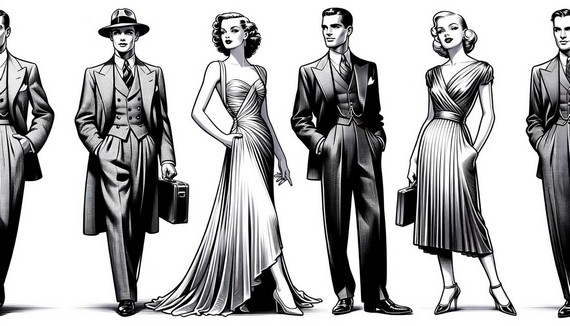
A montage of 1930s Hollywood stars like Greta Garbo, Marlene Dietrich, and Clark Gable, showcasing their influential fashion styles
Technological and Material Innovations
The 1930s saw significant technological and material innovations that transformed fashion, making it more accessible and dynamic.
Madeleine Vionnet’s popularization of the bias cut was revolutionary. By cutting fabric at a 45-degree angle against its weave, she created garments that flowed with the body’s natural curves. This method allowed for greater fluidity and movement, resulting in elegant, form-fitting designs that remain influential today.
New materials also emerged, changing the fashion landscape:
- Rayon: Known as artificial silk, gained popularity due to its affordability and versatility. It mimicked the luxurious feel of silk but was more durable and less expensive.
- Nylon: Invented in 1927 and commercialized in the late 1930s, revolutionized hosiery with its durability and sheerness.
The zipper, though invented earlier, gained widespread acceptance in fashion during this decade. Elsa Schiaparelli’s 1935 collection, featuring brightly colored plastic zippers, helped popularize this functional and modern alternative to buttons and hooks. Zippers allowed for closer-fitting garments and aligned with the streamlined aesthetic of the era.
These innovations had a profound impact on the accessibility and affordability of fashion. Man-made fibers and zippers lowered production costs, allowing designers to create luxurious yet affordable garments. This was particularly advantageous during the Great Depression, enabling more people to afford stylish clothing.
Advances in textile printing and dyeing techniques expanded the range of patterns and colors available. From bold geometrics and florals to rich earth tones, fabrics became a canvas for designers’ creativity.
By marrying style with technology, the 1930s fashion industry embraced modernity, practicality, and elegance. These innovations broke down barriers, making high fashion more accessible and setting the stage for future advancements that continue to influence the industry today.
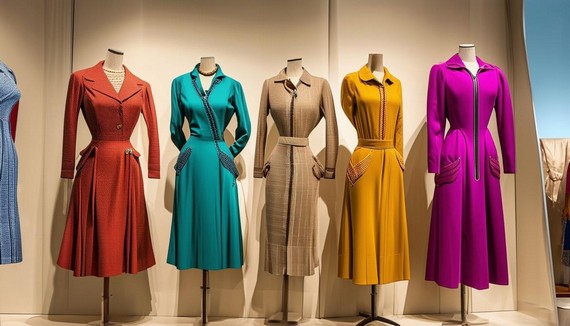
A display of 1930s fashion innovations including bias-cut fabric, rayon and nylon materials, and colourful zippers
The 1930s were a pivotal time in fashion, blending innovation with Hollywood glamour. New materials and techniques, coupled with silver screen inspiration, created a decade that celebrated both elegance and accessibility. This era shaped the foundation of modern fashion, influencing how we approach style even today.




